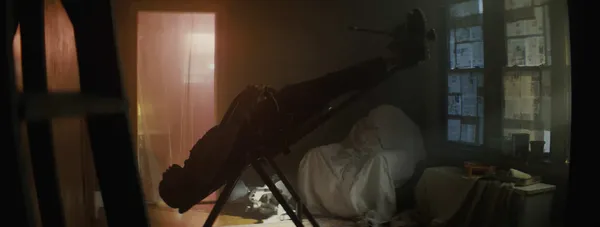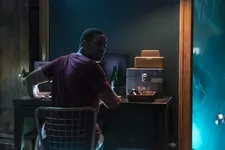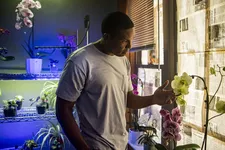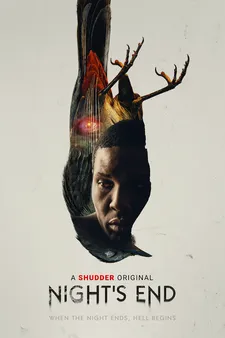 |
| Geno Walker in Night's End Photo: courtesy of Shudder |
A last minute addition to Frightfest’s 2022 Glasgow Film Festival line-up and now available on Shudder, Night’s End is an occult thriller with a heavy dose of humour. It centres on Ken (Geno Walker), an agoraphobic alcoholic who is trying to get his life back together and start his own YouTube channel providing marketing tips. When a stuffed bird falls off a shelf behind him during an online conversation with a friend, Ken recounts a story about his flat being haunted, and the friend suggests that there’s a much bigger audience interested in that – but turning to an exorcist to address the situation leads to danger. It’s the latest work by Jennifer Reeder, whom I spoke to previously about her festival hit Knives And Skin, so I reconnected with her to discuss it and began by asking about the circumstances under which it was shot.
“We shot it over 13 days, last summer,” she says. “The world of of micro budget indie production was still under pretty strict Covid compliance regulations. It's our hope that five years from now, when hopefully Covid is in our rearview mirror, no one says ‘That's really a Covid film.’ I mean, I like thinking of it as, certainly, an isolation film, a shut in film. But yeah, we we did what we could with all of us wanting to make a film during a time when it still felt really impossible to make a film.”
 |
| Ken at his desk Photo: courtesy of Shudder |
It feels very different from other films made in similar circumstances, I note, but it must have been a challenge to direct, just from a practical standpoint.
“Yeah, well, the primary guide was that all of the actors came in and performed totally by themselves. So we would bring in, for instance, Felonious Munk, who plays Terry – we brought him in on on the day by himself, we built out just his background, and he was acting to our script supervisor, you know, so he and Ken were never acting together. We shot in one location in one apartment, on the north side of Chicago, over 13 days, but all actors came in just one by one. And obviously we were testing every other day. We were doing regular check-ins, everybody was masked, but I would still be in an adjacent room directing, because of course all the actors were unmasked.
“I found that sometimes when you're in another room, trying to yell directions, it's hard, but then with, additionally, having a mask on, there were some times when Geno was just like, ‘I can't hear you,’ and I would have to march and stand in the doorway and give directions. The scale of the film is much smaller than we've ever had, just just to deal with the restrictions on how many bodies could be in a space at a time.”
Auditioning in that situation began with self tapes, she says.
“We were relying on a taped audition with just the specs that we knew about the person. I had worked with Kate Arrington before, who plays Kelsey, so I knew who she was and what she could do. I'd seen Larry Grimm in a play before, I had met Theo before, I'd met Daniel Kyri before, but I'd never met Geno before in person. I just wanted to cast him based on his self tape. And I'd also never met Felonious before. He did a self tape, but he also has done stand up, and so I was interested in what that dynamic might bring, but also it's a little intimidating because, you know, someone can feel one way on a self tape and then they show up in person and it feels quite different. We lucked out.
“I hadn’t considered Michael Shannon and Kate Arrington to be Chicago based. They come back and forth between here and New York a lot. We really made an effort to cast all out of Chicago and we just happened to find this little tiny 13 day window when everybody was between other projects. Because the people that we got, it's a real dream cast, but everybody is really busy. Geno is a featured actor on this really brilliant show called South Side and Daniel Kyri is a lead on Chicago Fire, and Kate and Michael had to go back to New York to do other things, too. So we had this little window where we got this dream cast.”
 |
| The orchid room Photo: courtesy of Shudder |
We talk about the different ways that people have been learning to communicate in lockdown, the sudden glimpses that we’ve been getting of people’s homes and home lives, and the possibilities that opens up for telling stories even with static camera positions.
“I worked with this amazing production designer, Adri Siriwatt, who was the production designer for Knives And Skin,” says Jennifer. “Just talking about how to curate the video conferencing frame, because that's how we see everyone except for Ken. Sometimes we see Ken in his own self tape, video conferencing space, but then oftentimes we see him also just in his own space. So we are there with Ken, but everybody else, we knew we were going to just see them through a screen. And so working with Adri, we really wanted to curate those spaces, to give us just enough information about that character's environment and make it seem believable, because at the end of the day, we were shooting all in one location.
“Often, if the camera had moved a couple of inches in either direction, just outside of our video conferencing frames was hair and makeup and the craft table. We had to really get particular about what was in someone's background, but also make sure it wasn't too flat. We also had to figure out how far we could get from the actor and their environment to make that seem believable.
“I think people who've seen Knives And Skin understand that production design and art direction is really important to me as narrative content. So I just thought, we can't dismiss that even though we're dealing with a limited and very flat space, and with those screens, you know, working with the VFX team. We didn't shoot any of that stuff actually with a webcam, we shot it with a beautiful Arri Alexa with anamorphic lenses. It was really important to me that we deal with the screen light in a very cinematic way. We were very particular about the kind of subtle filter that got put on the screen. So it was like there was some pixelation in there and we were building in some little digital glitches and getting the colour right.
“In some of the shots when we're looking at the screen over Ken's shoulder, there's a very minimal menu bar at the bottom of the screen. You don't want these kind of screen moments to be gunked up with lots of bad graphics, you know. We wanted to keep the screens as elegant as the footage that we shot in Ken’s actual house.
 |
| Don't answer the door Photo: courtesy of Shudder |
“We've always wanted to think about Ken having a very particular way that his daily routine plays out. He's got almost no furniture. The most active room in the house is this kind of taxidermy room, and then the orchid room. We tried to, at least in the orchid room, in particular, use that as a way to suggest his unravel. So for instance, the first time that he's in the orchid room, it's in pretty good order, and then at some point, when he's when he's having quite a bad day, we see that the orchids are unattended, there's some that are knocked over and they're kind of moved around, there's beer bottles in the orchid room, and then he kind of straightens it back back up when he's feeling a little more confident.
“I also just wanted to suggest that his anxiety is related to stomach problems, so he's having this consistent relationship with a pink liquid, an antacid that goes directly into his coffee, which of course is totally antithetical to how that works. But I just wanted to have that moment that feels both funny and concerning the first time he opens up that cabinet and it's just all of the rows of his pink antacid. So some of the moments are supposed to feel awkward, be funny and also concerning, but we tried to shoot Ken in quieter moments with a lot of sympathy and a lot of a tenderness. At the end of the day, I want an audience to feel a genuine tenderness towards this man who is in grave peril.”
And then contrasting with all that realistic stuff, there’s the world of YouTube channels focused on paranormal stuff and all of the bad graphics and so on that goes with that. Did she watch a lot of those to get it right?
“Yeah, we did. The writer, Brett Neveu, and I watched a lot of ghost hunting YouTube channels, and, even if it wasn't about paranormal hunters, the more popular YouTubers, Tik Tok users et cetera, who are versed just enough in their own production to kind of make something that doesn't feel entirely amateur, but the taste is questionable, at the end of the day, in terms of their font choice or their colour schemes. And actually, that stuff was super fun to make. You know, sometimes it's actually hard to make something look crappy if you are someone who has a real aesthetic, and so you’re figuring out like, ‘Does that look crappy enough?’ But also like it would appeal to a certain kind of demographic, a consumer of that kind of that kind of content. There were some really fun and funny conversations in the art department about getting some of that stuff right.”
 |
| Night's End poster |
We discuss the way that he shift in styles between those different elements helps to create tension,. and the simple but very disturbing shots when the camera creeps towards the door of Ken’s flat from the outside.
“This seems to be to be kind of a classic horror trope, but hopefully not in a way that feels tired,” she says. “You know, you want the audience to be like, ‘No, do not answer the door.’ When the trailer for Night’s End dropped, some of the comments were that typical kind of like, ‘Why do people stay in haunted houses?’ Or ‘Why do people go answer the door when there's a mysterious knock?’ We wanted him to be just curious enough about this very menacing knock at the front door to have to go and look into it, but it also felt important that...” She pauses for a moment. “What was not initially in the script was this idea that he was a kind of a shut-in, that he has a fear of completely leaving. Because if he actually had the ability, mentally and otherwise, to leave the apartment, then then he would just say ‘Forget it, I'm going to break my lease.’ Being a shut-in and realising that your apartment is haunted, you know, that just felt like there was a lot of a lot of room for tension and some scary moments.”
I tell her that something I like about the film is that it raises questions which are not asked as often as they should be in horror film, such as whether or not Ken should trust the random strangers on the internet who offer advice when he’s looking for a solution to his problems.
“Yeah, that was also something that I really loved about this script. You know, the idea that this guy who was really at the end of his rope would reach out for help to someone who he certainly trusted as being a paranormal expert. And I like the idea of taking a character from bad to worse, you know? Ken’s arc is actually kind of a reverse arc in the sense that he ends up in a much worse place than where he began.”
Night’s End is now available to watch on Shudder.





















